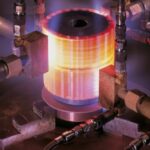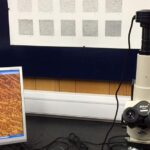This test is employed for detection of small defects which are very small to detect with the naked eye. This test is used to detect surface cracks or flaws in non-ferrous metals. This test employs a visible colour contrast dye penetrant technique for the detection of open surface flaws in metallic and non-metallic objects. The penetrants are applied by spraying over the surface of material to be inspected. The excess penetrant is then washed or cleaned. Absorbent powder is then applied to absorb the penetrants in the cracks, voids which reveals the flaws. This test reveals flaws such as shrinkage cracks, porosity, fatigue cracks, grinding cracks, forging cracks, seams, heat treatment cracks and leaks etc., on castings, weldings, machined parts, cutting tools, pipes and tubes. If the fluorescent penetrant is used, the developed surface must be examined under ultra violet light to see the presence of defects. This technique is used for non-porous and non- absorbent materials. Care may be taken to clean the surface so that it is free from dust, scale, etc. to have better results. Penetrants are highly toxic and flammable and hence proper precautions should be taken both during use and of storage of penetrants.

Posted inMaterial Science
Liquid-Penetration test
Posted by
 admin
No Comments
admin
No Comments
Suresh Kumar is a passionate mechanical engineer with deep expertise in design, thermodynamics, manufacturing, and automation. With years of experience in the industry, they simplify complex engineering principles into practical insights for students, professionals, and enthusiasts. This blog serves as a hub for exploring cutting-edge innovations, fundamental concepts, and real-world applications in mechanical engineering.
Post navigation
Previous Post
 Strain Hardening
Strain HardeningNext Post
Microstructural Exam 
